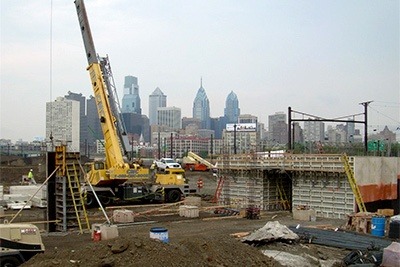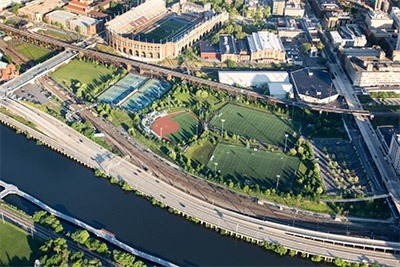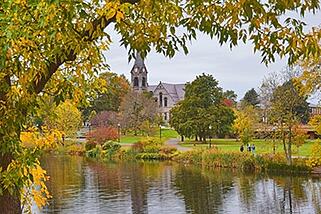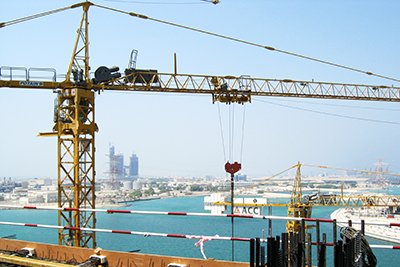A beautiful campus can strengthen a college or university’s identity, connect the campus to the surrounding area, and support academic and strategic objectives. As universities and colleges grow their campuses must too but, for many institutions, available land for campus growth is scarce.

As institutions seek to grow and develop facilities that are attractive to students, researchers, academics, and parents, “second-tier” sites, such as a back lot or adjacent industrial land, are becoming part of the campus. Often these sites have very complex soil conditions — weak, contaminated, or inhospitable to plant life. These conditions often require costly and time-consuming solutions, particularly when discovered after a plan has been developed.
To avoid costly surprises, it’s important to see and understand the factors that can impact the landscape plan. And what you don’t see can carry some big risks. Many campus plans are just that — plans — until they are grounded in the reality of cost, complexity, and practicality.
Campus planners need to work with design teams and their consultants to understand the whole picture and incorporate the strongest solutions and approach into plans. When it comes to planning for soil conditions, here are four steps you can take:
- Encourage partnerships: It’s important to have a cohesive team that works well together and understands how to meet campus objectives from many angles – both above and below the ground. A geotechnical consultant working in partnership with your landscape team can help identify subsurface risks and provide solutions early in the design process to align with expectations for design performance and sustainability. Later in this blog, I will discuss how Haley & Aldrich and Michael Van Valkenburgh Associates (MVVA) partnered to create the University of Pennsylvania’s Penn Park, an urban park connecting the campus to Philadelphia.
- Use what you have: Unless your campus is brand new, you probably have some information on your below-grade conditions that may impact your plans. Your cohesive team can use this information at the concept stage to identify subsurface conditions for landscapes that require additional information or a special technical response. This helps with early phase cost estimates and risk management.
- Get the appropriate level of information early: It is important to understand the soil conditions impacting landscape planning and design early so that design development can proceed with the right information to develop an informed design that meets your objectives. You will need to learn the considerations and questions to ask when confronted by challenging subsurface conditions. For example, what due diligence is required, when to use historic site information, or how to best align subsurface exploration programs with future design and owner’s risk tolerance.
- Be creative: A creative design team knows there are many ways to overcome technical challenges to meet campus landscape planning objectives. In the world of the subsurface, that might mean using Styrofoam building blocks to lighten the load of a new landform, mixing cement with your soil to make it stronger, or treating and containing contaminated soil.
When it comes to expanding your campus onto undeveloped land, “what lies beneath” can impact plans, costs, and schedule — or derail your goals altogether. To lessen or avoid these challenges, follow these four simple steps to go beyond skin deep.
Creative solutions turn design and geotechnical challenges into opportunity for the University of Pennsylvania’s urban Penn Park
The University of Pennsylvania’s “Penn Connects” vision is a land use and urban design campus plan intended to advance Penn as a premier urban research university. Part of the Penn Connects vision was to redevelop a derelict 24-acre parcel of land on the Schuylkill River to create an urban gateway between the campus and downtown Philadelphia. The solution was to create Penn Park, an urban park featuring interwoven recreation and athletic components.
To help Penn deliver on its vision, landscape architects MVVA partnered with Haley & Aldrich and together they turned challenges into opportunities. For example, MVVA developed an innovative landscape design vision that combines the experience of a park within state-of-the-art athletic facilities. To achieve that vision, numerous geotechnical challenges had to be overcome. These challenges required Haley & Aldrich to develop creative solutions such as using ground modification to stabilize the subgrade, reinforcing earth mats to distribute loads, utilizing a range of foundation types for various structures, and applying highly permeable soils to allow for on-site stormwater reuse.
This landscape architect and geotechnical engineering partnership helped transform 24 acres of undeveloped land into green space, athletic fields, and other public venues, living up to Penn’s aspiration to connect the campus with the city.
Aerial image courtesy of Alex MacLean at MVVA.
Published: 12/15/2016



